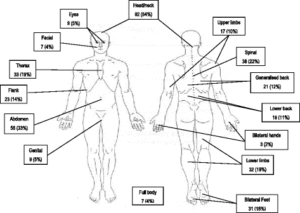
Pain in amaXhosa women living with HIV/AIDS
Pain is one of the most commonly reported symptoms in people living with HIV/AIDS. The prevalence of pain in women living with HIV/AIDS may differ from that of men as many chronic pain conditions are more prevalent in women than in men. This higher prevalence rate may be a reflection of cultural acceptance for women to report pain, but it may also be a consequence of differences in physiology between men and women.

Parker, Jelsma and Stein investigated pain prevalence, characteristics and management in 229 amaXhosa women living with HIV/AIDS. Almost 75% of the women interviewed reported pain, with the most frequently reported regions being the head/neck, followed by the abdomen.
The study highlights that pain risk is not purely due to the fact that being female increases risk for developing pain. Research finds that socio-economic status has also been identified as a risk factor for pain. More than half of the women in the study were unemployed (66%), while other studies have identified low levels of education as increasing risk for pain.
Pain is a common problem for amaXhosa women living with HIV/AIDS, but routine pain assessments could aid the management of pain and the psychiatric comorbidities that accompany it.
Learning to live with osteoporosis
Osteoporosis is a chronic condition that can lead to bone fractures and become debilitating if left untreated, but it is highly treatable in healthy individuals. A diagnosis of osteoporosis allows initiation of treatment before bone fractures occur, but the diagnosis itself can lead to difficulties for patients, who therefore may not follow the prescribed treatment.
Hansen et al. conducted a longitudinal qualitative study to explore patients’ experience of osteoporosis in the first year after diagnosis in order to understand where improvements in treatment could be helpful. The longitudinal nature of the study allowed for an in-depth understanding of the evolving process of learning to live with new life circumstances after a diagnosis of osteoporosis. They found that the decision to initiate, continue, or discontinue medication was a key theme of the women’s experiences. The results highlight the need for shared decision-making to increase compliance and improve outcomes for patients.
How hormone therapy affects quality of life and breast cancer risk after surgery
In March, a systematic review conducted by Siyam et al. investigated the effect of hormone therapy on quality of life and breast cancer risk after risk-reducing salpingo-oophorectomy (RRSO), a surgery involving the removal of the ovaries and Fallopian tubes.
The authors found that several studies show the benefits of hormone therapy improving menopause-specific quality of life in symptomatic women who have gone through natural or surgical menopause. However, they were unable to draw conclusions relating to the safety of hormone therapy in relating to breast cancer risk, due to the lack of long-term studies available from which to draw conclusions. The authors urge the implementation of more well-designed randomized control trials in order to inform the use of hormone therapy post-RRSO, and in the interim, clinicians and patients must carefully discuss the potential benefits of hormone therapy in improving quality of life, in the context of the unknown risk of breast cancer in this population.
Male attitudes and experiences towards conflict-related sexual violence

For the female survivors of sexual violence, the consequences of are not purely physical; many survivors face negative social outcomes, such as rejection by their family or community. Survivors of sexual violence in eastern Democratic Republic of Congo (where this study took place) have stated that the stigma and shame they feel after rape can be more traumatic than the attack itself, due to these adverse societal results. Recent research has found that male relatives play a critical role in how the community responds to the survivor of this violence.
Kelly et al. investigated, through the use of focus groups, the sensitive questions surrounding spousal acceptance and rejection after an instance of sexual violence.
Their results highlight the complexity of the topic, and how an interaction of factors affects the acceptance/rejection of a survivor of sexual violence. One the topic of “love and affection”, two contradictory views can be seen. The first:
“As I was in deep love with her, my decision came easily to keep her”
In comparison to:
“Even if you love your wife, if you see her be raped, the love vanishes”
Overall, the drivers of rejection included the fear of sexually transmitted infections, the personal stigmatization and social isolation of men and the financial or logistical inability to provide adequate healthcare for survivors. Love and affection, financial contributions by the survivors, and children in the home were described as pathways to acceptance.
Implications of male circumcision for women in Papua New Guinea
It has been found that male circumcision has the potential to reduce the risk of female-to-male transmission of HIV, and as such, is now being investigated as a possible HIV prevention technique in Papua New Guinea.
In a three-phase study conducted by Redman-MacLaren et al. the researchers first investigated women’s understanding of and experience of male circumcision. In the second part of the study, focus groups with women were employed to understand the processes women use to manage the outcomes of male circumcision. Lastly, participants helped identify local-level actions that could assist in HIV policy.
During the focus group, the researchers found higher educational level was associated with women having more choice relating to whether a man’s circumcision would influence with whom they will have intimate relationships, as well as whether they will push for their sons to be circumcised. Regarding the latter, one woman interviewed said:
“I wasn’t aware of that, now that I’m aware, believe me, I’m going to have all my boys in my family, I will do it and I’m gonna do it. I will have to get them circumcised, that’s it.”
The research found that women in Papua New Guinea are very knowledgeable on the topic of male circumcision, despite the idea of it being “men’s business.” However, women’s opinions regarding male circumcision is often related to a lack of safety, a consequence of a lack of opportunities for education and gender inequality in Papua New Guinea.
Comments